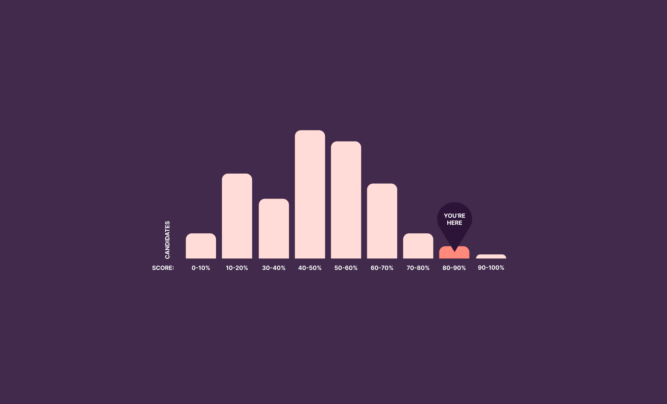Asynchronous interviews bring to the recruitment process what online learning brought to education — a strong, viable alternative. Because, let’s face it, the hiring process in most organizations is still incredibly inefficient.
Recruiters and hiring managers spend way too much time at the top of the hiring funnel trying to spot qualified candidates. Worst of all, they use traditional interviews to assess the competence and shortlist top performers.
While they can’t solve every modern hiring issue, asynchronous video interviews offer organizations a leaner, more scalable screening process and a better candidate experience.
TL;DR — Key Takeaways
- Asynchronous video interviews are a key component of the asynchronous hiring process, allowing for flexibility in conducting interviews, especially for remote teams across timezones hiring for remote roles.
- The asynchronous hiring process, including async video interviews, offers numerous benefits to both recruiters and candidates, mostly in terms of enhancing efficiency and convenience.
- Async video interviews are a great solution for screening at scale, particularly with tools like Toggl Hire’s pre-recorded video interviews.
What are asynchronous video interviews?
Put simply, an asynchronous video interview is a pre-recorded video interview where an applicant is guided through a series of interview questions and records their answers in front of a phone or computer camera.
The key feature of an asynchronous video interview is that a candidate is not speaking with a recruiter in real time but rather recording their answers using video interview software.
For this reason, you’ll often see the term ‘asynchronous video interview’ used rather than just ‘asynchronous interview.’
As video interviewing has become more and more popular in hiring, it’s now best practice for recruiters to record a short video intro, too, rather than just expecting candidates to overcome their stage fright.
It also helps recruiters and hiring managers introduce the position and company in a compelling yet scalable way, as the same video recording is distributed to all candidates. This way, the experience is as close to a structured ‘normal conversation’ as possible for all parties.
| Asynchronous Video Interview | Traditional Video Interview |
| Doesn’t happen in real-time; the Recruiter and candidate complete their part asynchronously | Takes place in real-time, with everyone present on the call |
| Pre-recorded video answers must fit within a given time limit | Both the interviewer and interviewee can easily go off-track with rambling thoughts |
| Requires video interview software or a built-in platform capability (e.g. Toggl Hire) | Any video conference tool can serve the purpose (e.g. Zoom, Google Hangouts) |
| Used as an additional step in the screening process between a resume check and an in-person interview | Typically takes place after the CV and phone screen as a way to shortlist candidates |
What is asynchronous hiring?
Asynchronous hiring is a recruitment process that leverages various forms of asynchronous communication and candidate evaluation steps to save time and create a convenient, time-zone-independent experience for candidates and employers.
For a simpler explanation, we can break the term down into two words.
Obviously, you know what hiring is, but it’s the asynchronous part that may confuse you. According to the dictionary, asynchronous refers to “two things that don’t exist or occur at the same time.”
In some ways, it’s easier to think of this as the opposite of synchronous. Imagine two dancers up on stage, but rather than dancing together, they dance two different dances. They aren’t in sync; instead, they’re asynchronous.
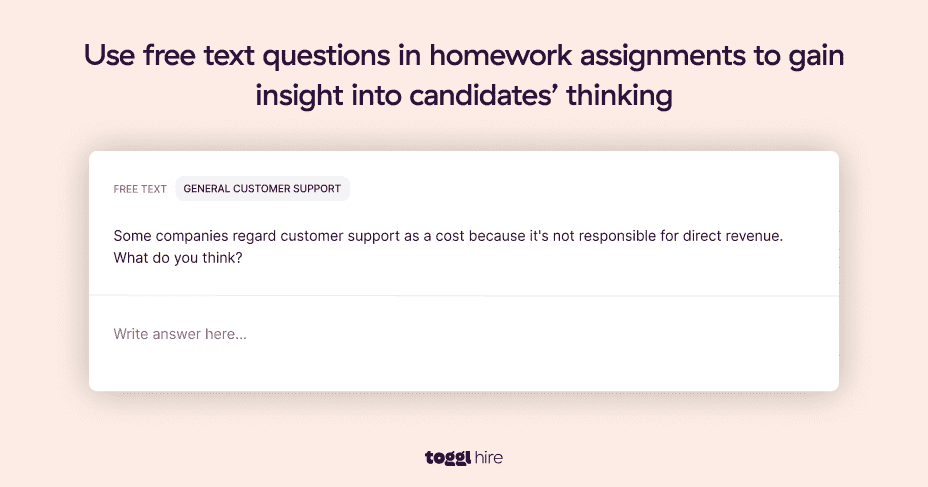
Asynchronous hiring, therefore, refers to activities in your hiring process where the candidate and the recruiter do things at different times. In these situations, the hiring process is done without any live or co-located tasks – each one acts independently.
Here are some examples of how replacing live touchpoints with asynchronous alternatives looks in practice. 👇
| Before Asynchronous Hiring | After Asynchronous Hiring |
|---|---|
| Initial candidate intro call | Initial candidate email intro |
| Recruiter meeting to discuss candidates | Shared notes on Toggl Hire |
| Delivering feedback over the phone | Feedback shared via email or voicemail |
| In-person/video interview | Pre-recorded video interview |
What are the common use cases for an asynchronous video interview?
Asynchronous video interviews are most commonly used to replace traditional phone/filter interviews. They allow recruiters to assess a candidate’s soft skills early on in the hiring process while helping them save time setting up multiple calls. While it’s not common, asynchronous video interviews may also replace full interviews.
And, of course, an async interview is a fantastic tool for remote hiring. Recruiters no longer have to deal with time-zone management and interview scheduling. With asynchronous video, it’s easy for recruiters and candidates to ‘speak’ to each other at a time that works for them, no matter which time zones they work in!
💡 Note: You may see asynchronous video interviews called ‘one-way interviews‘ or ‘pre-recorded interviews‘ — by and large, they all mean the same thing!

The benefits of asynchronous interviews
We’ve touched on them briefly above, but here are the key benefits for both the recruiter and the applicant when it comes to asynchronous video interviews.
1. Speed up your time-to-hire
Async interviews boost time-to-hire by allowing you to screen multiple candidates at once.
Let’s say you want to screen 30 candidates. Usually, that means scheduling and attending 30 separate phone interviews. Now, all you need to do is record your intro video once, select relevant asynchronous video interview questions from a built-in question pool, and let candidates respond all at the same time.
Slotting in 30 calls may have taken a whole week; async interviews take a matter of hours!
2. Screen for critical, dealbreaker skills early
Asynchronous video interviews are one of the best ways to assess a candidate’s critical skills early in the process — especially when compared to phone interviews.
Async interviews allow you to test candidates’ communication skills, including verbal and non-verbal cues, such as body language, facial expressions, or voice control.
When hiring for customer-facing roles like customer success, sales, or events management, these skills are at the core of what makes people successful at their jobs.
3. Allows collaboration
A candidate’s video response goes into a single system where you and your colleagues can collaborate on their assessment.
Gone are the days of relaying the phone interview to others, as you and the team can work together on assessing video interview submissions. As a hiring manager, you can review video answers at your convenience and provide feedback asynchronously.
And if another stakeholder enters the recruitment process later, they’ll have a full picture of the shortlisted candidate.
4. Creates a fair chance hiring process
If you’re concerned about fair hiring practices within your organization, asynchronous interviews are a great way to deliver consistency and reduce interviewer bias.
Every candidate gets exactly the same interview questions, providing the perfect environment to directly compare performance and eliminate unconscious bias.
Async video interviewing is considered a form of a structured interview, helping your hiring team make better-informed hiring decisions.

The benefits of asynchronous video interviewing for candidates
The benefits abound for businesses looking to save time and improve their hiring processes. However, in today’s digital world, asynchronous video interviews are great for candidates, too. Here’s why.
Convenience
Async interviews allow candidates to submit their answers at a time and date that suits them. This means they no longer need to make up awkward excuses at work to attend an interview or feel under pressure to complete interviews around their workload. Plus, with the option to practice questions and re-record answers, asynchronous interviews give candidates a chance to put their best foot forward!
Easily showcase skills
Video interviews provide candidates with a fantastic opportunity to stand out and showcase what makes them special early on in the recruitment process. Especially for customer-facing roles, it’s hard to show off personality on paper. But with a video, candidates can ditch the boring resume and let their personality and soft skill set shine through!
Company insight
Pre-recorded video interviews give candidates an insight into the company they’re applying to. Watching a pre-recorded message from a hiring manager or a recruiter can help candidates feel more relaxed and connect with the company to decide if it’s a good cultural and organizational fit.
While it’s possible to enter questions as text and let candidates record their answers via video, to deliver an authentic pre-recorded experience, you should record those questions in video format. This allows candidates to virtually meet someone from the company and learn more about culture fit.
How does Toggl Hire deliver amazing asynchronous video interviews?
At Toggl Hire, we’re focused on giving every hiring team the right tools to assess job seekers swiftly and fairly. While skills assessments work for one hiring manager, they’re not enough for another.
Job interviews can still dominate the hiring manager’s agenda and eat up a lot of time. The video intros feature of our hiring and talent assessment software is our way of automating the initial screening process without losing the human touch.
Video Intros deliver an amazing asynchronous interview experience for both recruiters and candidates:
- For the hiring team: the same video intro recording can be distributed to multiple job candidates. And you don’t need to wreck your brain for relevant interview questions. Simply dip into our pool of pre-suggested soft skills or behavioral job-specific questions and invite candidates to record their answers. When answers start rolling in, you can review, rate, and add notes in your own time.
- For the candidate: the user interface is slick and easy to use, with Video Intros often taking less than 10 minutes to complete. There is an option to re-record every answer, helping applicants to prepare, think of a suitable example to share, and show the best version of themselves.
Here’s how it all works in practice!
Step 1: Setting up
It all starts inside the Toggl Hire dashboard for hiring professionals. Simply head over to the ‘Video Test’ tab and turn on the Video Testing feature to get started.
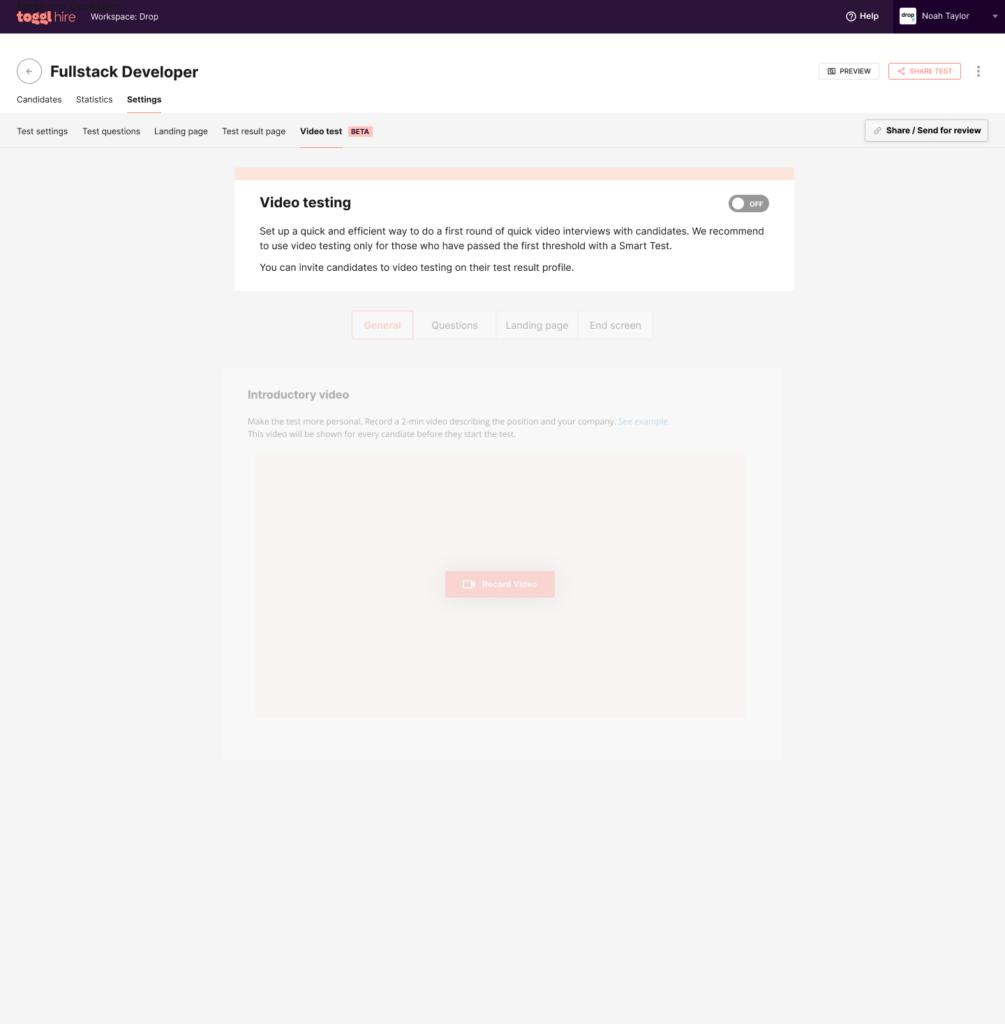
Once activated, record your own introduction. Within the ‘General’ sub-tab, you record your introduction video, telling candidates all about you, your company, and the role they’re applying for.
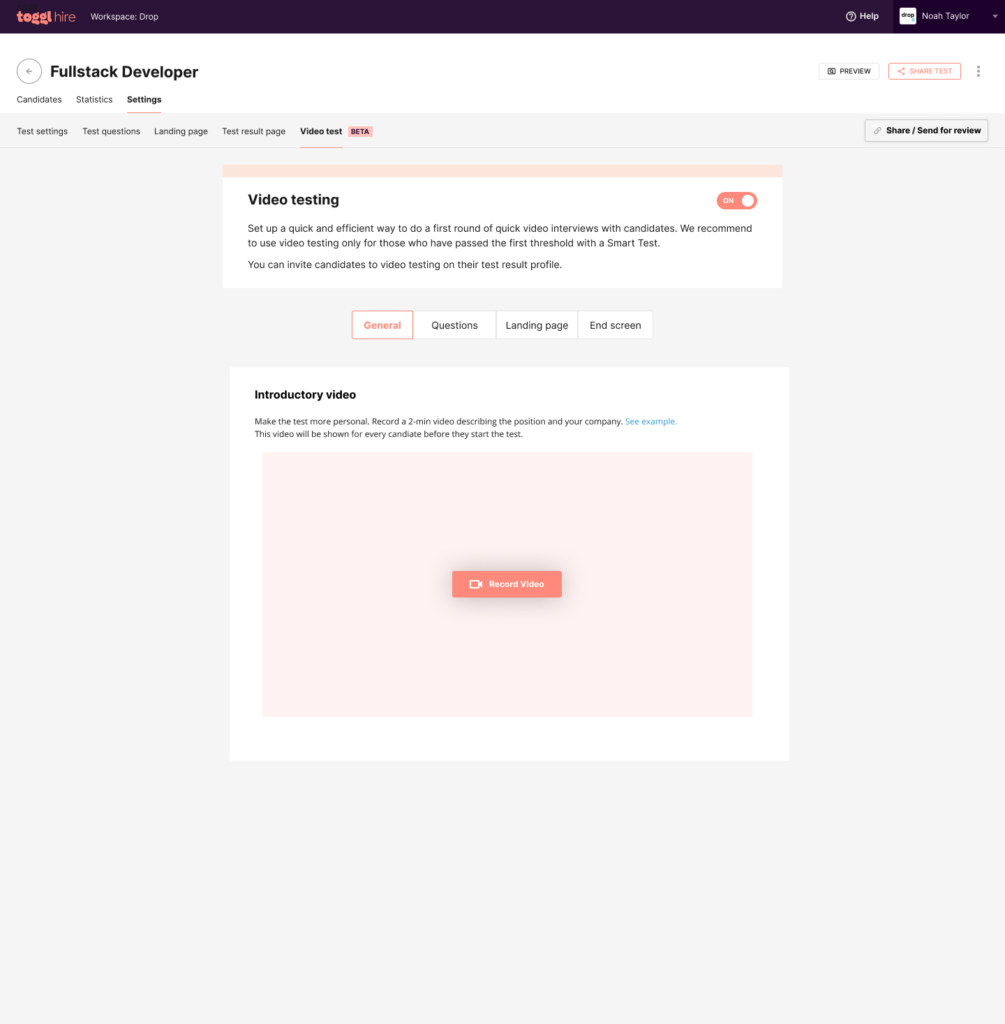
That’s your starring role complete! Now it’s time to configure the questions for the candidates. Choose your questions from our question library, or create a bespoke question for your role. You can set up to three questions and time limits to keep answers concise.

Time to add the sprinkles! With Toggl Hire, you can get your brand across by designing unique landing pages and end screens for your unique introduction.
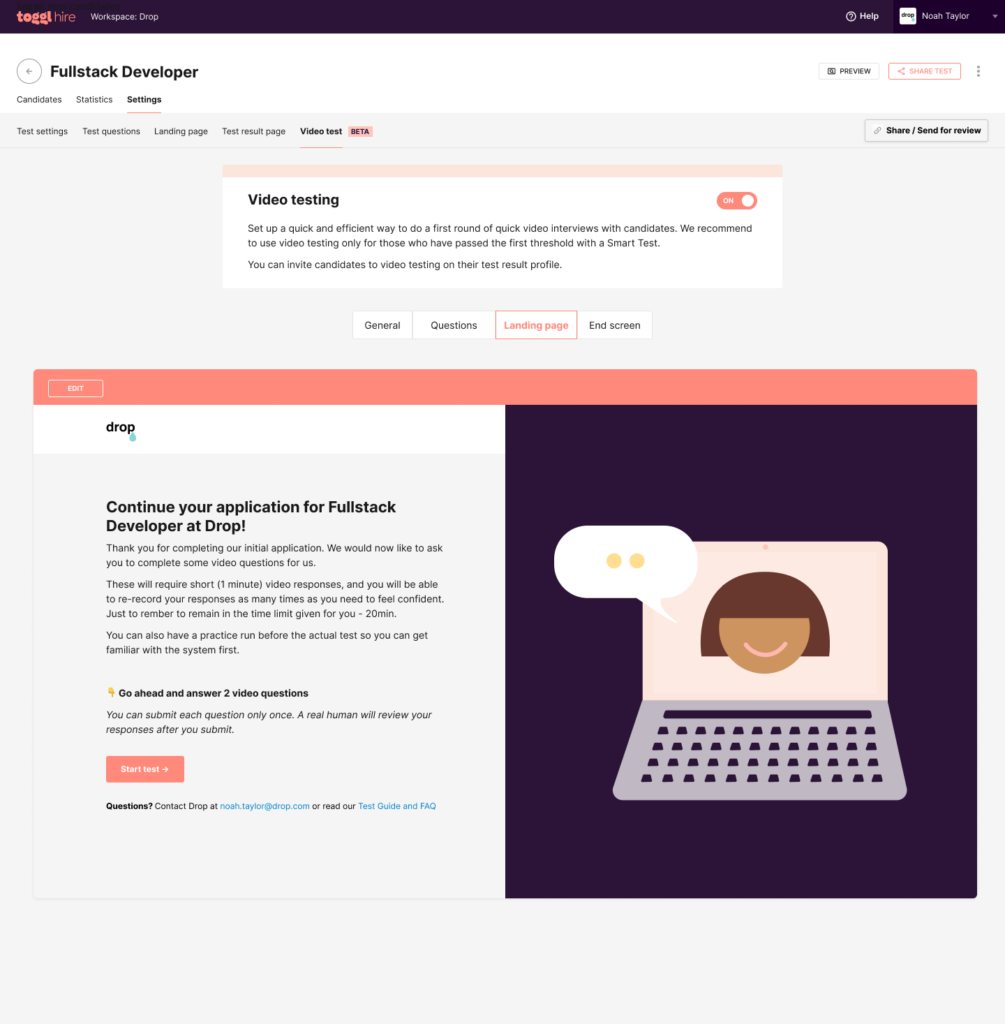
Step 2: Inviting candidates
Now that your Video Intros are all set up, it’s time to let candidates join the party. The great news is that it’s super easy to do straight from your Toggl Hire dashboard. Simply find the right candidates and invite them to take the video test.

Step 3: The candidate experience
Once candidates receive the Video Intros invite, they will be taken straight to your beautifully designed Video Intro landing page.
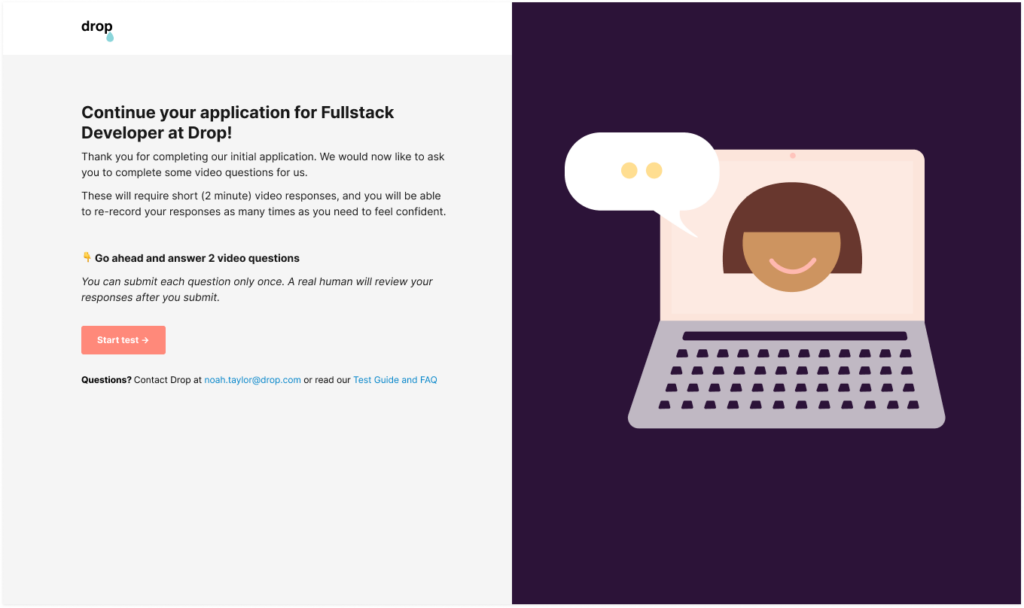
It’s easy for them to get started by watching your welcome message.
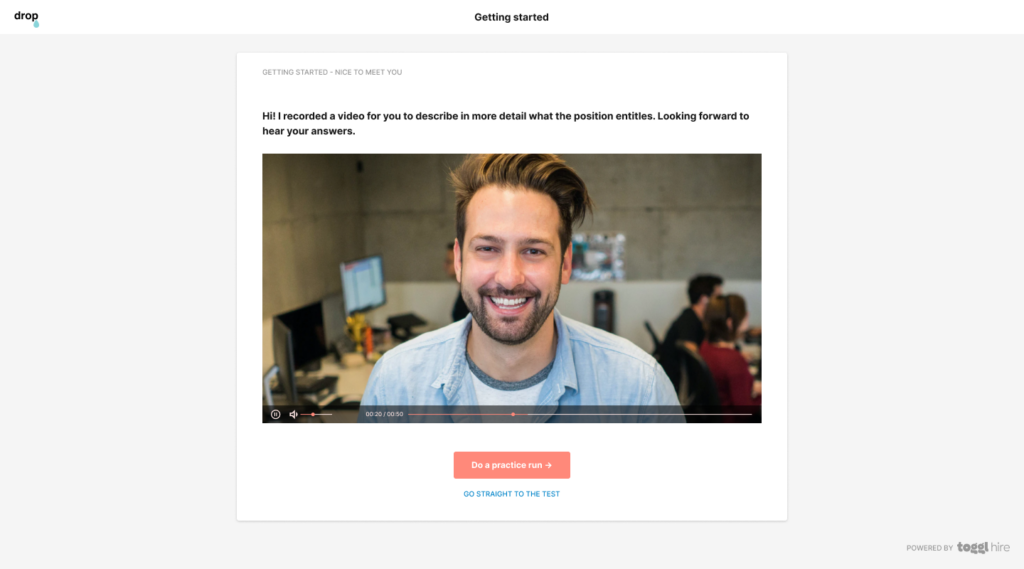
Now it’s time for your candidates to move on to the business part of the Video Intro, recording their answers! Using their device’s camera and microphone, candidates record answers to your questions, with the ability to practice and re-record until they’ve nailed the perfect response.
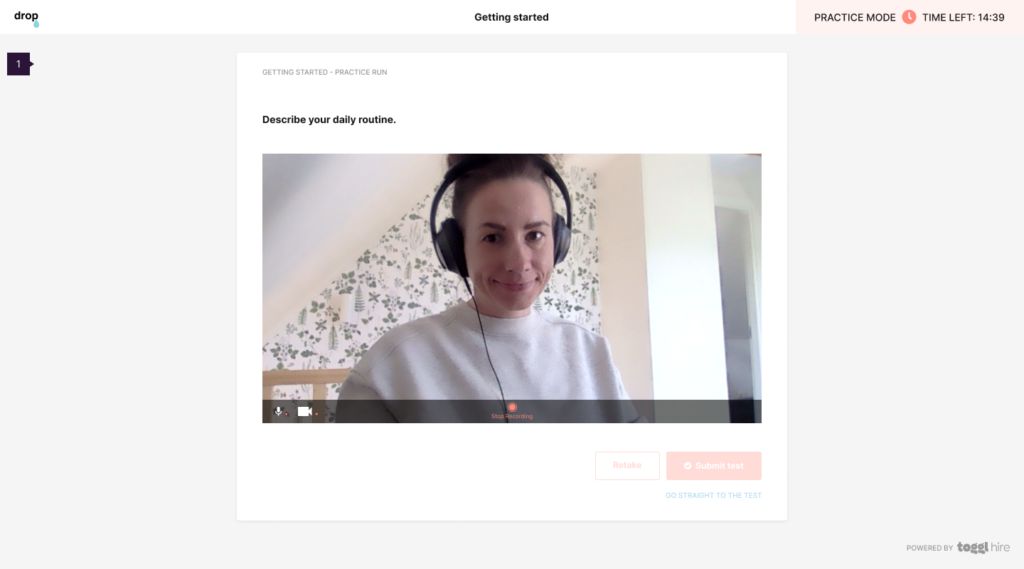
Once candidates are ready, they can submit their Video Intro responses back to you, ready for you and your team to review.
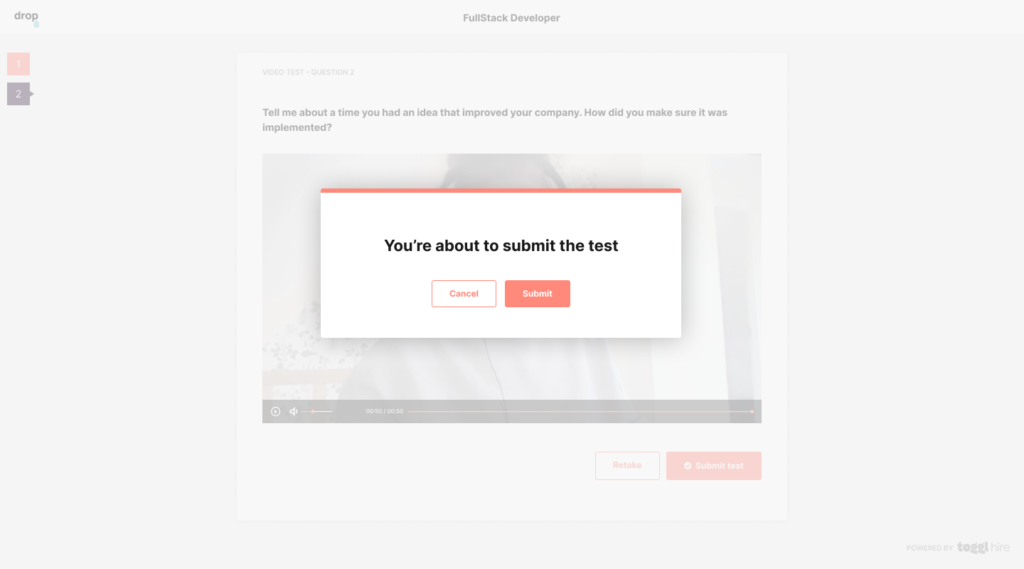
Step 4: Reviewing candidates
With your responses back in, it’s time to complete the process and review each candidate’s Video Intro. You’ll see all your candidates’ submissions and be able to provide instant feedback directly from the Toggl Hire dashboard.
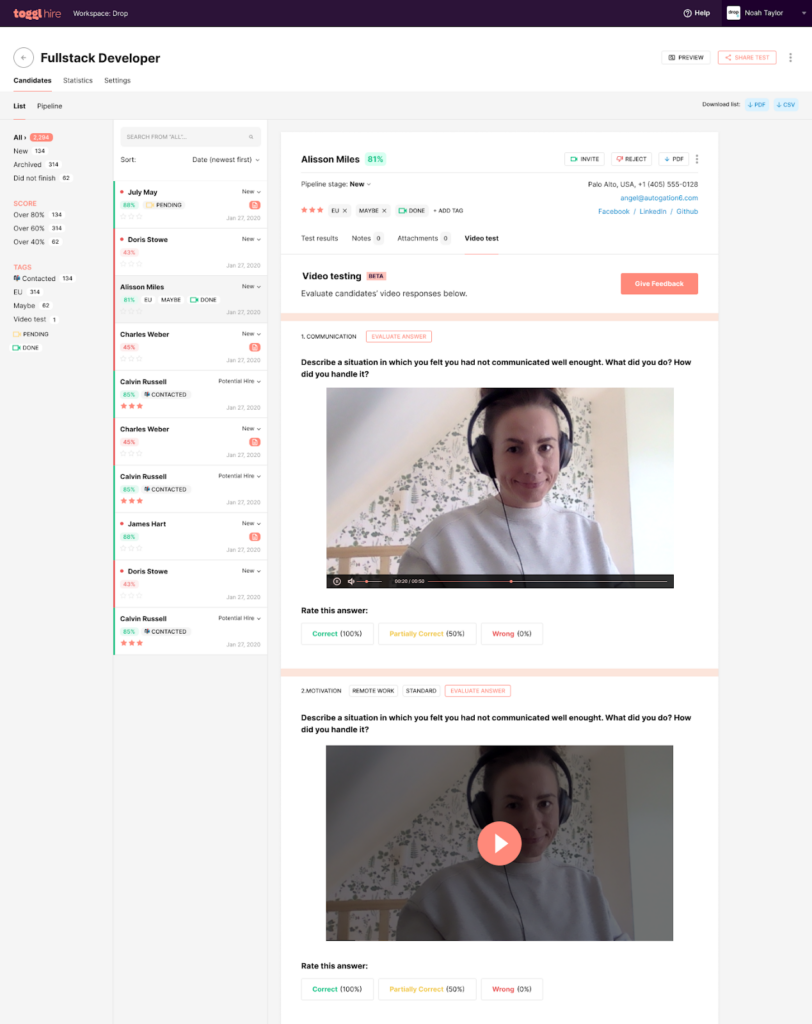
Start using asynchronous video interviews
With the rise of technology in hiring, asynchronous interviews allow recruiters and candidates to interview on their own terms, saving valuable time and money.
If you’re a recruiter who’s new to asynchronous video interviews, we’d recommend trying them out on your next vacancy. Not only do they save you time, but they allow your candidates to showcase their skills in a modern and innovative way.
Of course, we think our Video Intros feature is the bee’s knees. If you’d like to see more about it, you can watch this short video below.
Juste loves investigating through writing. A copywriter by trade, she spent the last ten years in startups, telling stories and building marketing teams. She works at Toggl Hire and writes about how businesses can recruit really great people.




